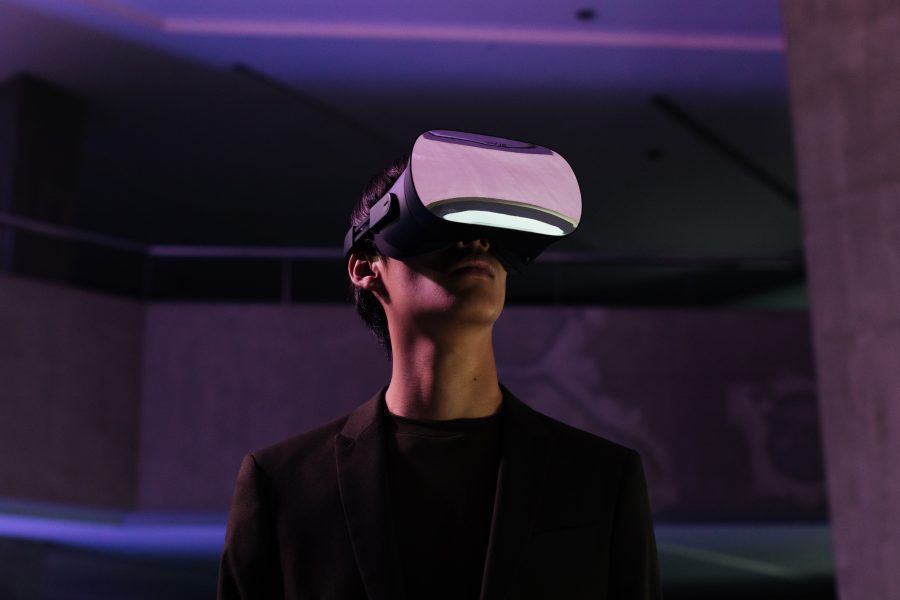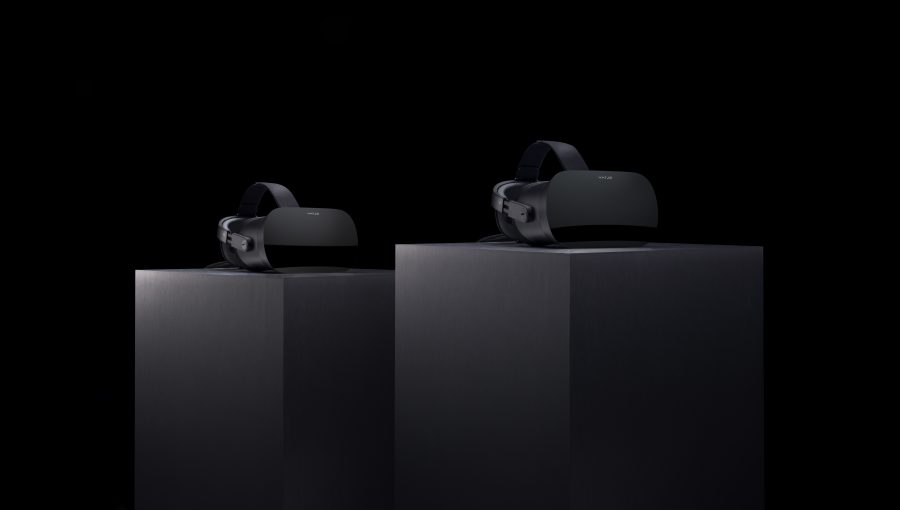What is a VR Head Mounted Display?
A head mounted display (HMD) is the part of your virtual reality equipment that you ‘wear’ to view your custom virtual environment. Initially, the VR headsets were cumbersome when the technology was in its infancy, modern headsets are ergonomically designed. This makes the HMDs easy to wear for longer periods of time while remaining robust.
Conventionally, commercially viable VR headset solutions deploy unique monitors for each eye – sealing you off from the outside world and preventing disruptive light bleed. Top of the range HMD models will deploy AMOLED screens to maximise picture fidelity and reduce blurring, or the creation of the ‘screen door effect’ which can result in motion sickness and massively reduce the quality of the image.
The HMDs have inbuilt elements such as gyroscopes, accelerometers, magnetometers, and more to allow the device to track your movement. When used in tandem with hand interfaces, this allows for a detailed and highly flexible way to interact with the virtual space you inhabit - allowing you to add additional value to your work.
While there may be a mountain of technical elements to consider, to simplify your VR HMD selection process, there are three different types of HMD on the market-
Self-contained: These standalone VR headsets are portable, battery-powered and have built-in processors, sensors, battery, storage memory, and displays, so they don’t require a connection to a computer.
Tethered: These HMDs have no on-board computing power and the headset is physically connected to a computer by cables, such as HDMI and/or USB.
Hybrid: These HMDs do a bit of both, having their own onboard hardware, but also allowing input from external devices.
A VR headset will also need to interface with controllers or other companion devices that will allow the user to control the program within the space. These can be as simple as a standard game controller, to specialised pieces of kit such as motion tracking rigs, feedback suits, and more.
However, when it comes to picking out the right enterprise HMDs for your business, it is worth taking time to understand the elements of a quality VR headset that can benefit your specific business needs. This can range from picking out a professional-grade HMD that is intuitive for your team to work with, easy to deploy as needed, or having specific elements like eye-tracking that are essential for your work.

How can HMD add value to your business?
HMDs have a wide range of uses from displaying virtual images and interacting, live streaming footage, deploying augmented reality and more.
While enterprise VR headsets can add value for businesses in several ways, some of the chief HMD applications include:
Aviation and military: HMDs are increasingly being integrated into the cockpits of modern helicopters and fighter aircraft. Virtual reality headsets can facilitate training of flight personnel and stimulate the real teaching environment.
Virtual environments work well in military applications. Military and tactical units use HMDs to display tactical information such as maps or thermal imaging data while viewing a real scene. The military makes use of VR techniques not only for training and safety enhancement but also to analyse military manoeuvres and battlefield positions.
Training and simulation: VR systems allow users to undertake a truly immersive experience, putting them front and centre in a virtual world. This makes it perfect for the delivery of training in a safe and controlled environment.
This is especially useful in sectors where there are issues around budgeting and safety, making it perfect for the defence and aerospace sectors and medical training.
An often-overlooked element of hazardous work is the aftereffect and risk to staff. Military personnel undertaking intensive drills can quickly suffer burnout or potentially risk causing harm to themselves and other individuals – something that is avoided altogether when considering an HMD for VR.
This can also extend to less rigorous work and involve social skills training – allowing team members to learn how to deploy a pitch properly, carry out important checklist tasks, and intensive examinations correctly – where deploying human trainees may not be time or cost-effective.
Engineering: Being able to quickly realise and visualise a design can be incredibly helpful when it comes to rapid prototyping. This allows an object to be built on a program such as CAD and then walked around in a variety of scales. This allows engineers and scientists to interact with their designs in full life-size scale, identify engineering issues, design problems and more.
VR headsets are extremely useful in exacting or important design fields such as automotive design or architecture. Selecting an enterprise VR HMD lets designers create a virtual experience of occupying a physical space, whether it is the interior of a vehicle or a walk-through of a proposed building. This allows you to review your aesthetic in a range of conditions and ensure that it is fully fit-for-purpose.
Research: One of the main benefits for VR is its ability to be cost-effective, allowing users to create a range of situations that may not be financially viable to replicate. This can be as simple as allowing the users to embody the experience of another individual or understanding how changing elements can result in state changes – something that can be easily captured by eye-tracking or by deploying simple tools such as biometric tracking.
VR headsets can also be very useful when it comes to carrying out product research on in-house branding, producing marketing materials, and understanding how consumers honestly react to products. Securing this information allows you and your teams to make significant changes in materials – capturing validated insight in a cost-effective way that would be impossible under conventional circumstances.
The fact that many VR systems can output to multiple screens means that participants can collectively review material – making what many would perceive to be a singular experience accessible to all.

Best Enterprise-Grade Virtual Reality HMDs
When it comes to choosing a VR headset for enterprise and industrial use, the gold standard is state-of-the-art HMD offerings from Varjo: the VR-2 and the VR-2 Pro.
Their features include:- Eye tracking: The 20/20 Eye TrackerTM Allows you to capture eye data from users, letting you quickly understand and metricise what they see.
- Light-weight comfort: The headset can be customised on a user by user basis or quickly adjusted to make it comfortable for any client.
- Comprehensive catalogue: This includes an existing library of ready-to-go enterprise apps that let you conduct detailed research, crunch analytics, and a range of training programs in-house and with ease.
- Human-eye resolution Bionic DisplayTM: Offering ‘human eye level’ fidelity, with a resolution of 60 PDD per eye – eliminating the ‘screen door effect’ that can be an obstacle to many users. The model uses a display that combines two micro LEDs (1920 / 1080p) and AMOLEDS (1440 / 1600p) to deliver a 10k:1 infinite contrast ratio. Both include support for SteamVR content as well as support for the OpenVR development platform Valve at ultra-high resolutions (up to 40ppd/4k rendering per eye)
- Next Level Ergonomics: Created to be used for extended periods of time, both headsets come with a raft of wearability improvements, including an active airflow system, adjustable face cushions, easy eye calibration and IPD adjustment for each individual user




















